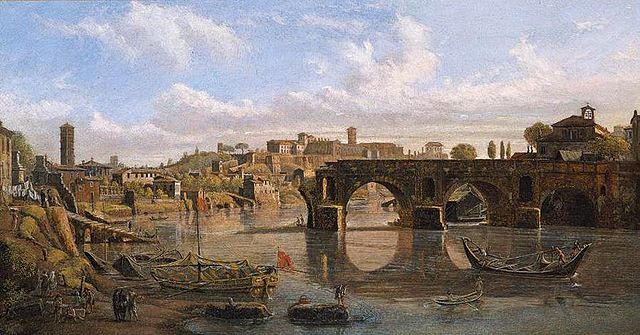
When it comes to old buildings the city of Rome has several that you can still visit this day. Unlike other cities around Europe Rome has several structures that are over 2,000 years old and still in use! Here are the top 4 oldest buildings in Rome that are still around.
Generally speaking, if you are visiting Rome today and want to see the oldest buildings that are still standing then you should check out these 4 amazing structures.
- Cloaca Maxima, 600’s BC
- Temple of Hercules Victor, 200-120 BC
- The Pons Aemilius, 142 BC
- Temple of Portunus, 120-80 BC
Each of these Roman structures is still around and you can visit them today! While many of Rome’s most famous buildings date from older periods you absolutely need to check out these 4 as they demonstrate how advanced ancient Roman engineering was. Our modern buildings will begin to fall apart after only a couple of decades, imagine building a solid stone building that stands after 2,000 years!
Here at The History Ace, I strive to publish the best history articles on the internet. If at the end of this article you enjoyed it then consider subscribing to the free newsletter and sharing around the web.
Without further ado; here are the 4 oldest surviving structures/buildings in the city of Rome.
1.) The Cloaca Maxima: 600’s BC (3,400 years old)
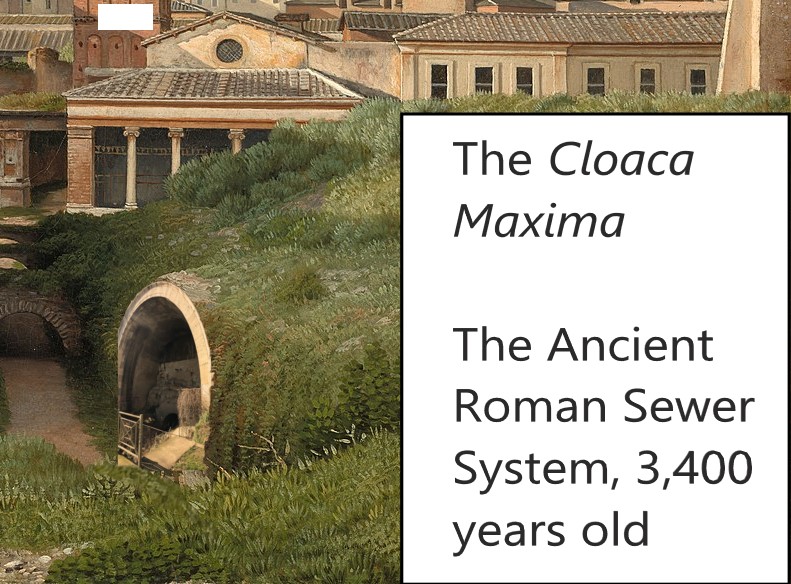
| Date Constructed | 600’s BC |
| Purpose of Structure | To drain the swamps of Rome and move sewage outside the city |
| Can You Visit | You can visit the outfall on the River Tiber right under the Ponte Palatino. Going inside without a permit is forbidden. |
| Further Reading | 3 Ways Ancient Civilizations Moved Water Uphill |
By far the oldest still-standing structure in the city of Rome is the sewer system. While other structures on this list are more well-known the most impressive is the Cloaca Maxima.
Built in the 7th century BC by the Roman King Tarquinius Priscus the Cloca Maxima is older than everything else standing in the city of Rome. This massive sever system was initially open to the air and ran alongside the ancient kingdom of Rome. From 500 BC up until 200 BC this sewer system would be expanded upon by widening the sewer, covering it with stone arches, and even at one point being able to send a gondola down the sewer system.
The purpose of this massive sewer system was twofold. First, not many people know but the location of Rome was initially a swamp with several large hills. This sewer system was built to drain this swamp and allow for the city of Rome to be built on top of it. The last king of Rome, Tarquinius Superbus, would fill in this swamp sometime between 534-509 BC with over 10,000 cubic meters of stone and dirt to create the foundation for the city of Rome.
The second purpose of this large sewer system was to allow the city of Rome to expand in population. As the population of Rome grew it became apparent that Rome was going to need to handle its growing sanitary problem. The Cloca Maxima was so complex that the ancient Roman historian Livy states that it was one of the two great wonders of ancient Rome!
Today, it is possible to visit the outfall of the Cloca Maxima although it is hidden. Nearly all the guests who visit the eternal city walk right past this engineering marvel that is over 3,400 years old. That is because if you are walking along the bike path on the Tiber River you will pass right by it. Under the Palentino Bridge you will see the outfall on the wall facing the old Roman Forum.
Today the Roman sewer system is still in use today! This makes this Roman structure both the oldest Roman structure and the oldest continually used sewer system in the world!
2.) Temple of Hercules Victor: 200-120 BC (2,222 Years Old)
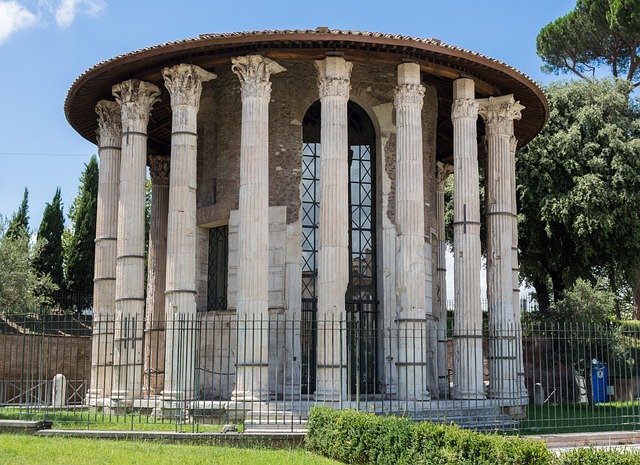
| Date Constructed | 200-120 BC, 2,222 years old |
| Purpose of Structure | Historians are still not sure |
| Can You Visit | Yes, but you can’t go inside. Location is right outside of the Palatino bridge |
| Further Reading | 2 Ways The Romans Recorded Information |
The oldest standing marble building in Rome is the unknown Temple of Hercules Victor. Built during the late 2nd century BC this temple’s purpose has baffled historians to this day.
What we do know about this massive temple was that it was located in the old cattle marketplace of the Roman Republic. The temple itself is one of the few built in Rome using marble imported from Greece. The columns that support the roof are corinthian in design and because of this, it is believed that the Roman Consol Mummius Achaicus was the one who built the temple. This is because Mummius Achaicus was the Roman general who conquered the ancient Greek city of Corinth
However, that is just one theory. Other theories state that the temple was a sacrificial altar for cows. This was because one of the major Roman festivals was the ritual of Fordicidia where priests would sacrifice a pregnant cow to the Roman god Tellus.
Today you can visit this temple which is located west of the colosseum along the banks of the River Tiber. It is free to look at the temple and which is located in the Italian Foro Boario park. You will need a guided tour to go inside the temple as it is very small and can only fit one tour at a time.
Still, this relatively hidden temple remains one of the best attractions in Rome. On a good day clear day, you can see the white marble reflect light onto the walls of the temple. The best time of the day to visit the temple is either at sunrise or sunset as it will not be crowded.
3.) The Pons Aemilius: 142 BC (2,164 Years Old)
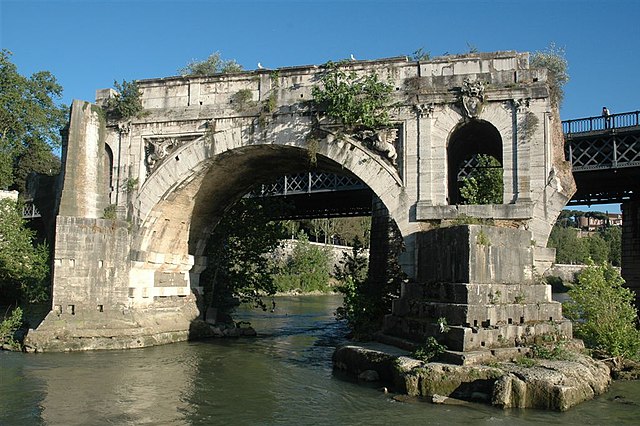
| Date Constructed | 142 BC |
| Purpose of Structure | Stone bridge to allow Romans to cross the Tiber river |
| Can You Visit | No, all that remains is one section next to the Palatino bridge. You can see this section from the bridge. |
| Further Reading | The 3 Things That Were Important To The Ancient Romans |
Another hidden old Roman structure that is still standing is what remains of the Pons Aemilius bridge. This bridge was constructed over a period of decades starting the year 142 BC. All that remains today is one section that you can still see in the River Tiber.
Originally during the Roman Republic, a wooden bridge linked the city of Rome with its neighborhoods on the other side of the Tiber river. After Rome’s victory in the Second Punic War, the wealth of the eternal city began to grow exponentially.
With this new wealth, Roman generals and statesmen started to build large monuments and buildings to demonstrate their wealth. One of these structures was a brand-new stone bridge that crossed the River Tiber. This bridge was intricately decorated and was one of the main ways to enter the city of Rome.
However, during the middle ages, the bridge fell into disuse as the city of Rome began to shrink in population. In the 13th and 16th centuries, floods would destroy all but one section of the bridge. Today this section is all that is left of the once lavish bridge.
Today you can not visit this structure as it is located in the middle of the Tiber river. You can however see it by walking across the Palatino Bridge and looking north. Or you can visit Tiber Island and on the south side get an amazing view of the bridge section from only 150 ft away. It is free to see this ancient Roman structure. The best time to visit this structure is at dawn, this is because the steam of the Tiber river will create an amazing glow in the morning sunlight.
4.) Temple of Portunus: 120-80 BC (2,142 Years Old)
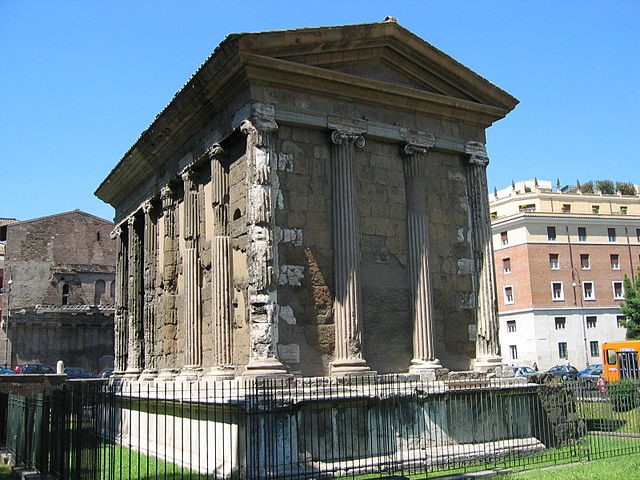
| Date Constructed | 120-80 BC |
| Purpose of Structure | To bless the cattle barges entering into the Roman city |
| Can You Visit | Not without a special guided tour. Viewing from outside is free. |
| Further Reading | Why The Romans Copied The Greeks |
Right next to the Temple of Hercules is the Temple of Portunus. This temple is over 2,000 years old and was the original temple in Rome that was dedicated to the Roman god Portunus, the god of food, ports, and gateways.
Originally in the bend of the Tiber River, there was a port called the Port Tiberinus. This old port was where barges of livestock and grain would enter and feed the growing city of Rome.
The Roman people were extremely superstitious and believed that they needed to protect their city by creating a large temple to the Roman god of Ports to ensure that they were protected from famine and disease. Just above the old Tiberinus Port, they erected this large temple sometime between 120-80 BC.
What is interesting about this temple is the columns on the front. They are not Corinthian or Doric but rather are Ionic in design. This might have been a representation of the ancient city of Athens and its mercantile power over the seas. The 1st century BC Roman architect Vitruvius remarks that these designs on the columns were purposely done to resemble a slender and refined approach.
If you want to visit this temple you can do so by going to the Foro Boario park right along the River Tiber. It is free to go into the park and you can check out the two temples there. The square one on the right is the Temple Portunus.
Conclusion
There you have it; the 4 oldest structures in the city of Rome that are still around.
All of the above structures are older than the more famous structures of the Pantheon and Colosseum. If you go visit these buildings and structures then you won’t have to fight to see them as most people don’t know about them.
Here at The History Ace, I strive to publish the best history articles on the internet. If you enjoyed this article then consider subscribing to the free newsletter and sharing it around the web.
Further, you can check out some of the other articles below.
-
The 4 Oldest Structures In The City of Rome That Are Still Around

The oldest buildings and structures that are still standing in the city of Rome. Here is everything you will ever need to know!


